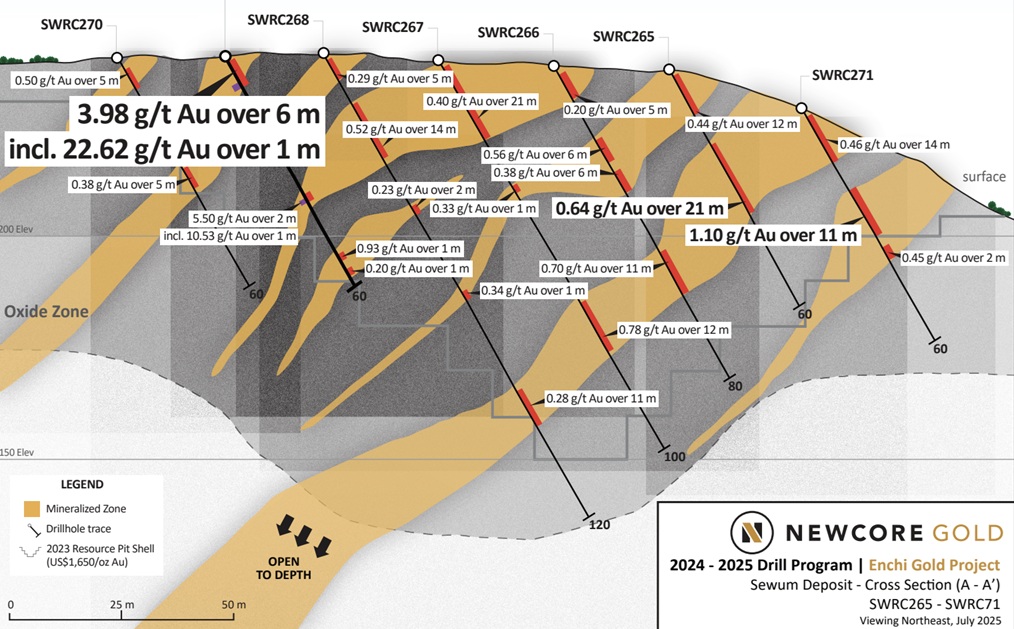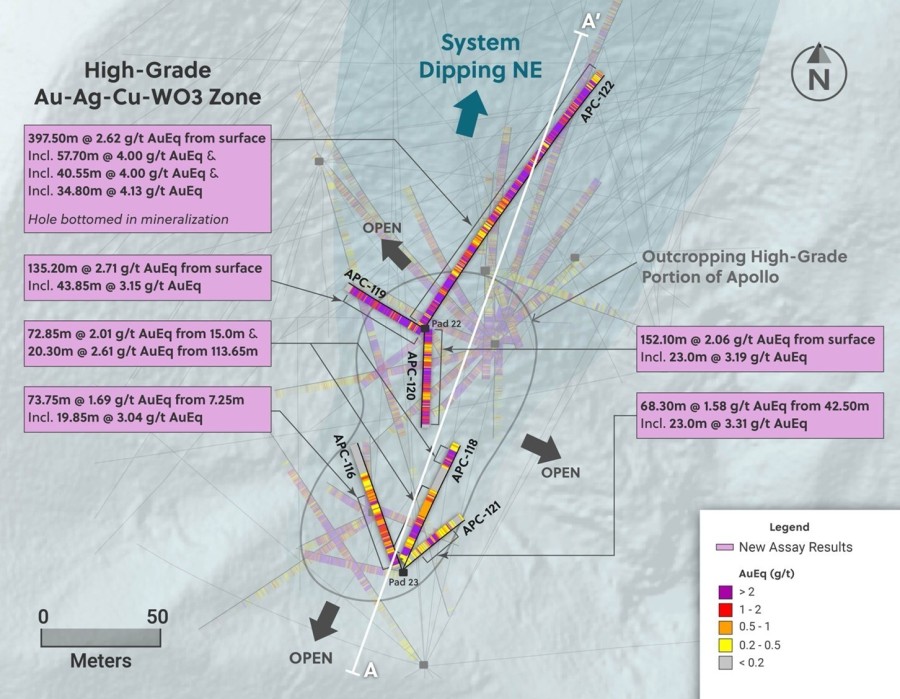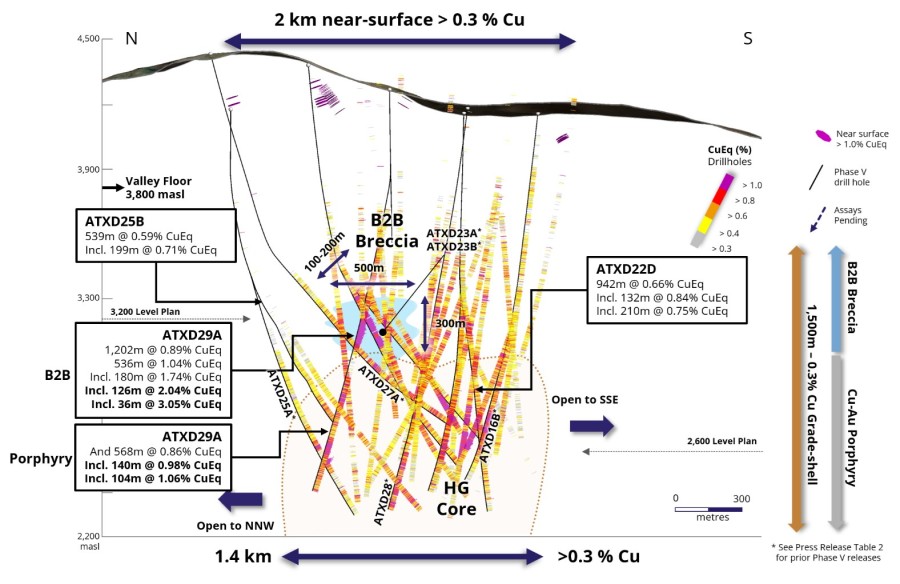Recent ANT survey validates third-party academic model of deep, structurally remobilized mineralization at Montauban - reinforcing district-scale exploration potential
Vancouver, British Columbia--(Newsfile Corp. - July 24, 2025) - ESGold Corp. (CSE: ESAU) (OTCQB: ESAUF) (FSE: Z7D) ("ESGold" or the "Company") is pleased to announce that recent seismic imaging results from its Ambient Noise Tomography (ANT) survey have provided possible validation of the Broken Hill-type (BHT) geological analogue first described in two historical peer-reviewed academic studies conducted by the University of Calgary (U of C) and the University of British Columbia (UBC). This combined geophysical and academic support reinforces the Company's view that the Montauban Gold-Silver Project shares significant genetic and structural similarities with the globally renowned Broken Hill deposit in New South Wales, Australia. However, many steps still remains before confirming this theory as well as few other possible comparison with some Scandinavian Massive Sulfide deposits.
Why This Matters
- Deep Structures Confirmed
ESGold's ANT survey imaged mineralized zones down to 1,200 metres, validating the depth potential of Montauban and supporting the vertical stacking model predicted by two academic studies.
- Academic Validation from UBC and U of C
Independent, peer-reviewed research confirms Montauban shares structural and geochemical traits with Broken Hill, one of the world's largest polymetallic deposits.
- Gold and Silver Remobilization Mechanism Identified
Both studies describe sulphide melting and remobilization as key processes that enriched and vertically redistributed precious metals - a critical factor for deeper discovery.
- Stacked Multi-Lens System Emerging
Combined geophysical and geological data point to a reworked VMS system with multiple lenses, fold hinges, and enriched zones yet to be drilled.
- District-Scale Potential Reinforced
The data shifts Montauban from a historic producer to a high-impact exploration opportunity, with scale and complexity often found in globally significant camps.
The data reinforces ESGold's evolving view of Montauban as a structurally complex, vertically continuous mineral system with similarities to globally recognized volcanogenic massive sulfide (VMS) districts - and positions the project for a transformative phase of exploration.
"These peer-reviewed publications provide powerful third-party support to our working theory on the Montauban system," said Gordon Robb, CEO of ESGold. "We are now combining academic research with advanced imaging and historical data to build an exploration plan that could unlock something far greater than originally envisioned. The independent research conducted by UBC and U of C reinforces what our own team is now uncovering through deep imaging. We are finding Montauban to be far more geologically complex and promising than previously understood. Seeing not one but two peer-reviewed academic analysis align so closely with the structural signatures in our ANT survey adds a new level of confidence to our exploration thesis - and strengthens our belief that Montauban may represent a rare, reworked polymetallic system with meaningful district-scale potential."
The University of Calgary Report
The geological study by Dr. Andrew G. Tomkins at the University of Calgary provides a peer-reviewed foundation for understanding Montauban as a complex, metamorphosed VMS system enriched in gold and silver. It demonstrates that prograde hydrothermal activity and sulphide melting during amphibolite-grade metamorphism led to gold and silver remobilization into wall rock zones-significantly expanding the exploration footprint. This validates ESGold's structural model and highlights untapped mineralization potential beyond the historically mined near-surface lenses, particularly along fold hinges and sheared contacts. The study reinforces Montauban's classification as a deposit with both economic remobilization and exploration upside, aligning with ESGold's broader district-scale thesis.
Tomkins, A.G., Pattison, D.R.M., & Frost, B.R. (2007). On the Initiation of Metamorphic Sulfide Anatexis. Journal of Petrology, 48(3), 511-535.
Key Technical Parallels Between Montauban and Broken Hill
1. Metamorphic Grade and Sulfide Remobilization
The Montauban deposit has undergone upper amphibolite-facies metamorphism (~650°C, 5 kbar), enabling partial melting of sulfide phases such as arsenopyrite. This mirrors the thermal conditions observed at Broken Hill, where granulite-facies metamorphism (~800-850°C) produced well-documented sulfide remobilization. Both environments exhibit vertical redistribution and enrichment of lead and silver.
2. ANT Imaging Confirms Vertical Continuity to 1,200 Metres
Caur Technologies' recently completed ANT survey imaged multiple low-velocity anomalies consistent with mineralized lenses - extending far beyond the previously tested depth of 400 metres. These findings support the remobilization and vertical stacking model identified in the University of Calgary study, marking a key milestone in ESGold's exploration thesis.
3. Sulfosalt and Silver-Bearing Melt Enrichment
Geochemical similarities include elevated antimony (Sb), bismuth (Bi), and silver (Ag), all of which preferentially concentrate in late-stage sulfide melts. This implies analogous melt-fluid partitioning processes at both Montauban and Broken Hill, affecting ore geometry and grade distribution.
4. Comparable Ore Assemblages and Thermochemical Behavior
Montauban's primary mineralogy - including galena, sphalerite, chalcopyrite, and pyrrhotite - aligns with that of Broken Hill. These assemblages are prone to forming sulfide melts under elevated temperatures, further validating the comparison.
5. Structural Complexity and Underexplored Depth Potential
Both systems exhibit boomerang-shaped, folded, and stacked sulfide lenses within metamorphosed host rocks. The Montauban sequence extends more than 2.5 km along strike and remains largely untested at depth. The ANT results indicate this vertical extent is far greater than previously assumed.
6. Rhodonite Indicator Discovery
Although not part of the original U of C study, ESGold's recent discovery of rhodonite - a manganese-rich metamorphic mineral commonly associated with Broken Hill-type systems - adds further weight to the analogue model.
The University of British Columbia Report (2007)
A peer-reviewed geological study by Dr. Andrew G. Tomkins, archived by the University of British Columbia, provides critical third-party validation of ESGold's structural and mineralization model at Montauban. The report identifies three key remobilization mechanisms-prograde hydrothermal activity, sulphide melting, and mechanical deformation-that collectively contributed to the formation of stacked, vertically persistent sulphide lenses within the deposit. These processes led to gold and silver redistribution and thickening of sulphides at fold hinges, consistent with features observed in the Company's recent ANT survey. This academic confirmation is highly significant, as it independently supports Montauban's classification as a reworked, multi-lens VMS system with substantial depth potential-further reinforcing the project's analogue to world-class polymetallic districts.
(Tomkins, A.G., 2007. "Three mechanisms of ore re-mobilisation during amphibolite facies metamorphism at the Montauban Zn-Pb-Au-Ag deposit," Mineralium Deposita, Springer-Verlag. UBC Archive)
-
Multiple Mechanisms of Ore Remobilization Identified
The study outlines three distinct ore remobilization processes at Montauban: prograde hydrothermal fluid flow, sulphide melting, and mechanical deformation. These contributed to the redistribution of precious metals and formation of stacked sulphide lenses, aligning with ESGold's current structural model. -
Fold Hinge Thickening Validates Vertical Continuity
Mechanical remobilization concentrated sulphides at fold hinges, resulting in structural thickening and lens stacking. This supports the interpretation of vertical continuity now observed through ESGold's ANT survey results exceeding 1,200 metres in depth.
(Tomkins, 2007, pp. 567-569) -
Sulphide Melting Led to Gold and Silver Redistribution
Amphibolite-grade metamorphism (~650°C) enabled melting of arsenopyrite and associated sulphides, leading to vertical migration of Au and Ag into new structural settings. This mechanism reinforces the interpretation of deeper mineralized trends at Montauban.
(Tomkins, 2007, p. 569)
- Complex Structural Overprint Confirms Multi-Lens Potential
The presence of hydrothermal pathways, melt-fluid interactions, and deformation structures described in the study confirms Montauban as a polymetallic system shaped by multiple remobilization events-mirroring global analogues like Broken Hill and substantiating ESGold's exploration model.
(Tomkins, 2007, pp. 570-572)
Next Steps
ESGold is executing a multi-track strategy to advance both development and exploration at Montauban:
-
3D Geological Model in Development: Integration of ANT survey data, historical drilling, VTEM, and structural overlays is underway to produce a refined 3D model that will guide upcoming drill targeting.
-
Montauban Site Construction Underway: Expansion of the Montauban processing facility and site infrastructure is progressing to support the Company's near-term production goals.
-
High-Priority Drill Targeting: Using insights from academic research, geophysics, and structural interpretation, ESGold is actively refining drill targets to focus on the most prospective zones for gold and silver enrichment.
-
Concentrate Sample Assays Pending: Tailings concentration testing is currently underway and the concentrate produced will be submitted to the lab, and assay results will be shared with the market once received and reviewed by the Company's Qualified Person.
Scaling Tailings-to-Cash-Flow Model: ESGold continues to advance its low-capex, high-margin tailings recovery strategy-designed to generate near-term cash flow while remediating legacy sites and unlocking untapped economic value at scale.
Qualified Person Statement
The technical content of this release has been reviewed and approved by André Gauthier, P.Geo. and P. Eng, an independent Qualified Person under National Instrument 43-101 - Standards of Disclosure for Mineral Projects ("NI 43-101").
About ESGold Corp.
ESGold Corp. (CSE: ESAU) (OTCQB: ESAUF) (FSE: Z7D) is a fully permitted, pre-production gold and silver mining company at the forefront of scalable clean mining and exploration innovation. With proven expertise in Quebec, the Company is advancing its Montauban Gold-Silver Project toward near-term production while unlocking long-term value through strategic redevelopment, modern discovery tools, and sustainable resource recovery. Montauban, located 80 km west of Quebec City, represents a blueprint for cash-flow-generating legacy site redevelopment across North America.
For more information, please contact ESGold Corp. at +1-888-370-1059 or visit esgold.com for additional resources, including a French version of this press release, past news releases, a 3D model of the Montauban processing plant, media interviews, and opinion-editorial pieces.
Stay connected by following us on X (formerly Twitter), LinkedIn, and joining our Telegram channel.
For further information or to connect directly, please reach out to Gordon Robb, CEO of ESGold Corp. at This email address is being protected from spambots. You need JavaScript enabled to view it.or call 250-217-2321.
On behalf of the Board of Directors
ESGold Corp.
"Paul Mastantuono"
Chairman & COO
This email address is being protected from spambots. You need JavaScript enabled to view it.
+1-888-370-1059
Cautionary Note Regarding Forward-Looking Information
This news release contains "forward-looking information" within the meaning of applicable Canadian securities laws, including statements regarding future production, cash flow, exploration results, project economics, and permitting. Forward-looking information is based on reasonable assumptions that management believes are current but involve known and unknown risks and uncertainties that may cause actual results to differ materially. These risks are detailed in the Company's public filings on SEDAR+. Readers are cautioned not to place undue reliance on such statements. ESGold disclaims any obligation to update or revise any forward-looking information, except as required by law.
Neither the Canadian Securities Exchange nor its Regulation Services Provider accepts responsibility for the adequacy or accuracy of this release.





